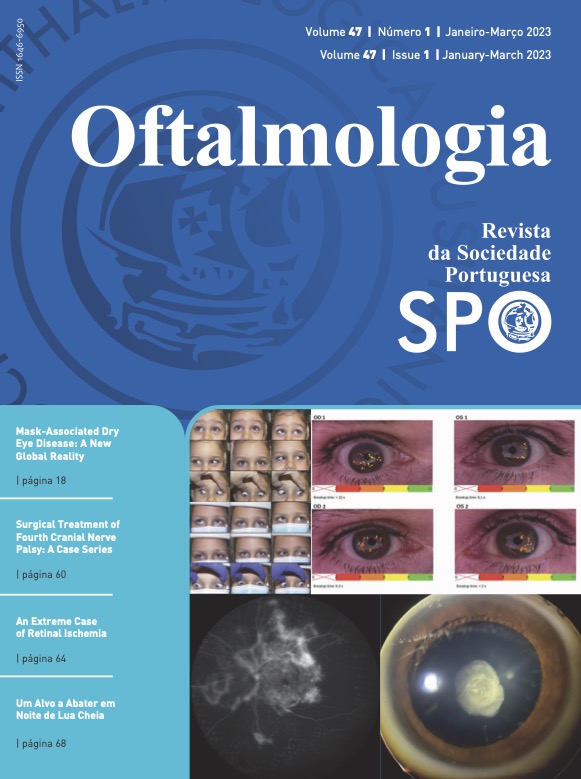Surgical Treatment of Fourth Cranial Nerve Palsy: A Case Series
DOI:
https://doi.org/10.48560/rspo.28787Keywords:
Ophthalmologic Surgical Procedures, Trochlear Nerve Diseases/surgeryAbstract
INTRODUCTION: Our purpose was to describe 4 cases of fourth cranial nerve palsy with different clinical presentations and corresponding tailored surgical techniques to correct ocular misalignment, diplopia and/or substantial abnormal compensatory head posture.
METHODS: Retrospective and observational case series study. All cases were followed in the Strabismus clinic of the Ophthalmology Department of Centro Hospitalar Universitário de S. João (Porto, Portugal).
RESULTS: Case 1 highlights a long-term congenital fourth nerve palsy in a 48-year-old pa- tient with significant inferior oblique (IO) overaction, successfully corrected with a recession of the IO. Case 2 consists of a 43-year-old patient with subacute onset of iatrogenic fourth nerve palsy, successfully corrected with a superior oblique (SO) tuck (significant intraoperative laxity of the SO muscle was evident in the forced duction test). Case 3 highlights a congenital fourth nerve palsy in a 2-year-old patient, whose abnormal head posture persisted despite anterior transposition of the IO due to residual excyclotropia, which was afterwards successfully corrected with a Harada-Ito procedure. Case 4 consists of a 32-year-old healthy patient with subacute onset of idi- opathic fourth nerve palsy (no history of trauma), who did not present IO overaction and had low potential for SO strengthening procedures. A recession of the ipsilateral superior rectus (SR) and the contralateral inferior rectus (IR) with 1 muscle-width nasal transpositions were successfully performed.
CONCLUSION: Fourth nerve palsies present multiple ocular motility patterns with varying degrees of SO underaction, IO overaction and cyclodeviations. To successfully correct them, one must study the affected patient extensively and understand the predominant anomaly, per- forming an individualized surgical treatment.
Downloads
References
Salmon JF. Kanski’s Clinical Ophthalmology: A Systematic Approach: Elsevier; 2020.
Von-Noorden G, Campos E. Binocular vision and ocular motility. 6th ed. In: Burian HM, von Noorden GK, editors. Theory and management of strabismus. St. Louis: Mosby Company; 2002.
Walsh FB, Hoyt WF. Clinical neuro-ophthalmology. Philadelphia: Williams & Wilkins; 1969.
Park UC, Kim SJ, Hwang JM, Yu YS. Clinical features and natural history of acquired third, fourth, and sixth cranial nerve palsy. Eye. 2008;22:691-6. doi: 10.1038/sj.eye.6702720.
Nixon N, Saward V, Barker L. 9 Paediatric ophthalmology and strabismus. Train Ophthalmol. 2022:409.
Bagheri A, Fallahi MR, Abrishami M, Salour H, Aletaha M. Clinical features and outcomes of treatment for fourth nerve palsy. J Ophthalmic Vis Res. 2010;5:27-31.
Duane TD, Jaeger EA. Clinical ophthalmology: Medical Department. London: Harper & Row; 2005.
Dosunmu EO, Hatt SR, Leske DA, Hodge DO, Holmes JM. Incidence and Etiology of Presumed Fourth Cranial Nerve Palsy: A Population-based Study. Am J Ophthalmol. 2018;185:110-4. doi: 10.1016/j.ajo.2017.10.019.
Ellis FJ, Stein LA, Guyton DL. Masked bilateral superior oblique muscle paresis. A simple overcorrection phenom- enon? Ophthalmology. 1998;105:544-51.
Knapp P. Classification and treatment of superior oblique palsy. Am Orthopt J. 1974;24:18-22.
Yumuşak E, Yolcu Ü, Küçükevcilioğlu M, Diner O, Mutlu FM. Outcomes of Unilateral Inferior Oblique Myectomy Surgery in Inferior Oblique Overaction Due to Superior Oblique Palsy. Turk J Ophthalmol. 2016;46:21-4. doi: 10.4274/tjo.02170.
Sanz PM, Escribano J, Gómez de Liaño P, Yela R. Surgical treatment of superior oblique palsy: Predictors of outcome. In- dian J Ophthalmol. 2017;65:723-8. doi: 10.4103/ijo.IJO_699_16.
Dwivedi R, Marsh IB. Superior oblique tuck: evalua- tion of surgical outcomes. Strabismus. 2019;27:24-9. doi: 10.1080/09273972.2018.1559204.
Bradfield YS, Struck MC, Kushner BJ, Neely DE, Plager DA, Gangnon RE. Outcomes of Harada-Ito surgery for acquired torsional diplopia. J AAPOS. 2012;16:453-7. doi: 10.1016/j.jaa- pos.2012.06.007.
Morad Y, Weinstock VM, Kraft SP. Outcome of inferior oblique recession with or without vertical rectus recession for unilateral superior oblique paresis. Binocul Vis Strabismus Q. 2001;16:23-8.
Apt L, Call NB. Inferior oblique muscle recession. Am J Ophthalmol. 1978;85:95-100.
Okamoto M, Kimura A, Masuda A, Mimura O. Surgical ef- fects of nasal transposition of inferior rectus muscle - 135 cases of acquired superior oblique palsy. Clin Ophthalmol. 2015;9:691-5.
Parks MM. The weakening surgical procedures for eliminating overaction of the inferior oblique muscle. Am J Ophthal- mol. 1972;73:107-22.
Parks MM. The Overacting Inferior Oblique Muscle: The XXX- VI Deschweinitz Lecture. Am J Ophthalmol. 1974;77:787-97.
Metten M, Link H, Staubach F, Bach M, Lagrèze WA. Dose- response relationship in inferior oblique muscle recession. Graefes Arch Clin Exp Ophthalmol. 2008;246:593-8. doi: 10.1007/s00417-007-0763-6.
Elliott RL, Nankin SJ. Anterior transposition of the inferior oblique. J Pediatr Ophthalmol Strabismus. 1981;18:35-8.
Mims JL, 3rd, Wood RC. Bilateral anterior transposition of the inferior obliques. Arch Ophthalmol. 1989;107:41-4.
Hatz KB, Brodsky MC, Killer HE. When is isolated inferior oblique muscle surgery an appropriate treatment for su- perior oblique palsy? Eur J Ophthalmol. 2006;16:10-6. doi: 10.1177/112067210601600103.
Downloads
Published
How to Cite
Issue
Section
License
Copyright (c) 2023 Revista Sociedade Portuguesa de Oftalmologia

This work is licensed under a Creative Commons Attribution-NonCommercial 4.0 International License.
Do not forget to download the Authorship responsibility statement/Authorization for Publication and Conflict of Interest.
The article can only be submitted with these two documents.
To obtain the Authorship responsibility statement/Authorization for Publication file, click here.
To obtain the Conflict of Interest file (ICMJE template), click here





